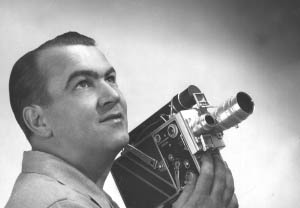
CHAPTER 11, Kilimanjaro Camp
Copyright
2003 William D. Snyder
All
Rights Reserved
Gatti
had all the drivers line up the vehicles in convoy so he could have a movie
shot of him blowing his first sergeant’s whistle, signaling forward with his
platoon leader’s arm, and then climbing in the lead station wagon and heading
out of camp # 1 at Kwale for Mount Kilimanjaro in Tanganyika.
Again I
was assigned to drive the last truck in the line up. Like the trip from Mombasa
to Kwale, I towed the Shack on Wheels “caravan” as the British call house
trailers in Africa. The dried mud of the roadway raised up in a billowy dust
cloud. The wind was calm, so the dust raised by the seven units ahead of me
lingered for a long time in the air. I could see where they were going by the
airborne trail.
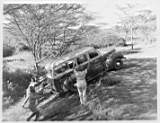
The
going was slow although highway traffic was nil. Most European people in East
Africa in 1948 traveled the 320 (check number) miles between Mombasa and
Nairobi by train; the highway trip was a two-day undertaking on narrow, dusty,
and washboard dirt roadway. We hadn’t motored very far when the convoy stopped and
parked off the roadway. I climbed down
from the cab and walked to where Gatti was trying to determine which fork in
the road to take. I would love to have a picture of our leader consulting a
Shell Oil Company roadmap and looking up at the sign post which held a number
of arrows painted with village names and mileage numbers. In my mind I could
see the caption, “Famed African Explorer lost on Kenya roads!”
After
Gatti made the road selection and the rest of the convoy departed, I waited
until the dust settled down before I brought up the rear. I hadn’t driven far
when we passed a tiny signpost that said “Drift.” Before I could slow down, the
red earth roadbed dropped precipitously away from the surrounding terrain and
the IH truck and the trailing caravan went plunging downward into a dry stream
bed crossing where a small concrete pad formed the bottom of the drift. The
cement was located where the water would flow in the rainy season. Immediately
the roadway zoomed up to bank on the other side of the stream bed.
The
drift was only 25 feet deep and approximately 100 feet from bank to bank, but
what a surprise! On the other side of the drift the truck was going up the hill
before the trailer finished going down. So when the rear of the Shack on Wheels
trailer wheels hit the concete bottom, the rear of the Schult scraped the
ground with a noise like hitting a steel drum with a sledge hammer.
I jumped
at the noise.
However,
I was busy deciding which to grab: the
trailer brake and the gear shift on the right hand drive export model truck.
Shifting with the left hand and trying to also use the trailer brake which was
American for left hand drive trucks and installed on the same side as the gear
shift, required fast action. I gunned
the truck up the bank and stopped when I was back on level land.
I looked
at the rear end of the Schult: I could tell the trailer had bottomed out, but
there was only minor damage to the carcass of the coach. I laughed to myself
when I thought of Gatti and his admonishment, “Keeping in mind the resale
value!”. I debated whether to tell him of the scrape, but vetoed the idea.
I didn’t
catch up to the main convoy, for I kept my speed down to avoid more contact
with the earth on the numerous drifts in the roadway.
To me
the trip was now interesting and fun. I enjoyed the countryside with its acacia
trees and wild animals grazing in the grasslands. As we went along there were
thousands of them along the route. Now and then I would drive close to small
villages of natives and Indian “dukas,” or shops.

The
local natives would stop and watch me pass through with a cloud of red dust
trailing behind.
Right
smack dab in the middle of one of the little villages, the International truck
engine coughed a couple times and died. I pulled off the roadway and tried to start the engine again. It didn’t take. I climbed out of the cab and lifted the hood. I had never looked
inside one of those hoods before, and I really didn’t know where to start. The
local natives gathered around and watched me struggle with the engine. I looked
in the cab for the instruction book. No
book!
All I
could think of was petrol problems. I did have tools in the cab so I began to
tinker I unhooked a gasoline line and blew in the gas tank filler. Sure enough, the line was somehow plugged, so I removed the gas line filter and after an hour or so went merrily on my
way.
The
African native audience which had built up to some size was left to disperse as
I left a trail of red dust behind.
I
finally caught up with the rest of the convoy two hours later; they were
parked, generators hooked up and running, and the crew sitting down for dinner
when I pulled into camp. Gatti was in his trailer, he and the memsahib were
busy with the Tangaray; but Powers welcomed me with, “We were about to send out
a search party for you.”
“How
come you didn’t circle the wagons?” I asked. “We should protect ourselves from
Indian and elephant attack.” Nobody thought it was funny. I joined them at the folding table for chow.
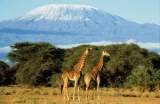
We could
see Mount Kilimanjaro for many miles on our approach to the highest peak in
Africa.
The
roads were the best that Tanganyika had to offer, but our safari convoy raised
at long cloud of red dust as it roared at 25 miles an hour across the veldt and
slowly climbed the roadway up on the mountain. The road wound its way through
picturesque tea and coffee plantations, past many native bomas and a mountain
resort for Europeans called the Kibo Hotel, and finally, out onto a flat
clearing where the view of the great mountain was spectacular.
At our
selected campsite, Gatti stopped his station wagon and directed traffic like an
African Askari in the city. We parked all the vehicles and the trailers in two
camps like we had done at Kwale and then gathered to hear our leader’s
instructions.
I was
taken by the beauty of the campsite; I’m sure the others were also, because
that was the first subject of conversation.
“How do
you like this camp area?” asked Gatti. “Isn’t that as grand view of the two
peaks? And best of all, we’re at an altitude of 6,000 feet where the nights are
cool and the days are not hot like down on the plains below.”
I was
impressed, it was a great place to camp. On our left front we had the highest
peak, volcanic Kibo at over 19,400 feet; on the right front stood the
jagged rock climber’s challenge, Mwenzi at 17,000, and to our front a saddle of
land at about 15,000 feet that connected the two peaks.. As I looked at the
snow cap on the Kibo peak, all I could think of was reading Ernest Hemingway’s “Snows of Kilimanjaro” short story in college. From the road into our camp one could see the plains below and imagine the drama as it played out in the hunting camp.
Gatti
had us park all the trucks and station wagons in a line suitable for a photo.
He insisted that the expedition flags be placed in the fender sockets. Our
sleeping facilities, the three Higgins campers, were also in a line, but well
away from the Shack on Wheels, the rhombic antenna, and the dining tent which
were centered in the clearing about the size of three football fields. The
Gatti’s campsite was located about 200 yards from ours.
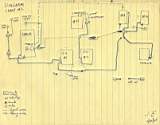
Our
first camp chore was to wire up all the trailers with power generators.
When that was done the CalTech electrical
engineering education in Bob came into play. He drew a wiring sketch of the
camp so every one would know how what to do next time we moved.
The
photographers were very happy with the water supply we were able route into the
photo lab part of the Shack on Wheels. The source was an irrigation ditch which
came from the snow melt waters on the mountain.
Weldon
smiled when he pulled the thermometer out of the water flowing through the
developing tank trough. “It’s exactly 68 degrees!” he exclaimed, “That’s
perfect for color processing!”
The
rhombic antenna went up in record time. Bob and I ran a compass line for aiming
the beam, then staked out the four pole locations, while Kombo and Asmani
unrolled the wires and ropes that formed the antenna.
In less than forty minutes we had the rhombic up and ready to take power from the transmitter. The antenna was aimed at Chicago, but it looked as if the main energy was beamed
right into Kibo peak. “I hope that volcano doesn’t soak up all our power we’re
blasting in that direction,” said Bob as we surveyed the finished job.
While we
were doing that, the cook and his toto helper erected the dining tent, started
a fire in the stove hole they dug in the ground, and were busy cooking our
supper. It was like the Ringling Brothers circus, in no time at all we were in
business with living and working equipment in place and operating.
The
first short CQ on the ten-meter phone band brought all the ham activity we
could handle.
“Where
you guys been? We’ve been looking for you,” said the first contact.
“We’ve
been moving for the last couple days and there ain’t no highways in this part
of Africa,” I explained. “It’s slow going on the roads, but now we’re 6,000
feet up on the highest peak in Africa and ready to work the world!”
And work
the world we did. Heretofore we had been operating with a Kenya call sign,
VQ4EHG.

Now we
were in Tanganyika, so we had to operate with our “mobile” call sign, VQ3HGE.
The
expedition call signs had been requested by Gatti long before we were picked to
go on the trip. In a letter, dated September 9, 1948 from the Chief Secretary
to the Conference of East African Governors in Nairobi, the call signs and
power limitations were spelled out to Gatti.
Apparently
he had asked for two types of licenses: base camp and mobile. The letter listed
VQ5GHE as
the base station and VQ5HEG as the mobile call while in Uganda;
with VQ3HGE
and VQ4EHG
for Tanganyika and Kenya respectively. The frequency and power limits were as follows:
1.8 - 2.0 mc (power up to 10 watts) 7.0 - 7.3 mc (power up to 150 watts) 14.0 - 14.4 mc (power up to 150 watts) 28.0 - 30.0 mc (power up to 150 watts) 58.5 - 60.0 mc (power up to 25 watts)
The
final paragraph in the Secretary’s letter contained the information I wanted to
know, but I was never shown it till years later. The restrictions of use were spelled out in plain English:
-
Within these bands the expedition may use its discretion as to the specific
frequencies it uses.
For
drinking water, Gatti had purchased a surplus Lister Bag as used in the United
States Army.
By
hanging it in the shade and dropping chlorination tablets in the water, it made
the contents potable. The melt water steam which flowed down below our camp
site made a good place to construct a shower for bathing.
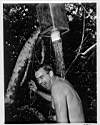
During
my days in the army in Australia, I daily showered in a portable shower bucket
that the Aussies had invented. It held about 3 gallons of water and was held up by a rope tossed over a tree branch. By a unique arrangement, a chain controlled the water which was dispensed in a
shower head. By putting the water in a 5 gallon cans and setting them in the
sun, a warm water shower was possible on sunny days. By carefully dispensing the water, it was possible to take a very good shower with only three gallons of water.
So, we
took an empty five gallon gasoline can and an empty quart film developer can
and constructed a reasonable facsimile of the Aussie shower bucket. Gatti was
quite impressed with our arrangements, so I explained the history of the simple
convenience. With a skilled cook, electric lights, running water and an operating shower bath, our camp living was quite comfortable and complete.
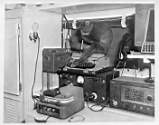
We
hadn’t been in Camp 2 long when we were invaded by the Bishop and some of his
priests from the nearby White Fathers Mission. After meeting Commander Gatti, the radio shack became a big attraction for the clergymen. The White Fathers were the first Catholic missionaries in East Africa and they were well established in the three countries the GH expedition visiting.
The
priests and brothers were all quite young, Bishop Byrne being the oldest.
During a conversation with one of them I learned that the life expectancy of a young priest was not much more than 30 years of age in the early days of century. Tropical diseases ran rampant through the Europeans who colonized the area and the Catholic clergy died rather young.
Gatti
was very solicitous of Bishop Byrne’s welfare and he offered to supply a radio
link to Chicago whenever the churchman wished. Not all the priests and brothers were from America, but those who were enjoyed talking to Chicago on the ham rig. The men at the Hallicrafters club
station were happy to make phone patches to some of the White Father’s Chicago
counterparts.
The band
conditions were excellent from the mountain location. With no atmospheric interference and no local power line noises to interfere, receiving conditions at the Kyouu location were superb. Ten meter amplitude modulated phone signals from the states were land line quality and the signal strength meter was almost always way above the S-9 mark on the dial.
It was
ham radio at its best!
The
instructions for the photographers came from Gatti daily. Now that Edwards was
the secretary, Gatti was able to dictate into the Audograph machine and have
the notes carefully typed on an “Underwood.” Here are extracts from those about
the pending climb of Mount Kilimanjaro. The “grammar” may have the reader
confused, but it is the way the commander wanted it—EXACTLY—as he would say.
-
Camp No.2. at KYOUU, T. T. February 26th,
1948 (underlined)
A.G.
Gatti
stayed in his office trailer most of the day; he dictated instructions for the
big climb that kept Edwards clicking away at the Underwood portable. Edwards
didn’t spend much time in cleaning up Gatti’s fractured speech, he enjoyed seeing Gatti’s use of “grammatically” instead of “dramatically” in the copy.
It was
later in the day of the 26th that the second instructional directive
for the climb arrived in our campsite. I got a kick out of it; Gatti did like
to dictate details that any working photographer would know.
The
copy:
-
Camp No. 2 KYOUU, KILEMA. T.T. February 26th, 1948 (underlined)
A.G.
Both
Errol and Weldon were competent commercial photographers, so they laughed at
some of the instructions. Errol said at the dinner table, “I’ve studied the poop sheet from the ad agency for the Canadian Club and Gatti hasn’t told me anything new. The agency says that we can’t have blood or injury showing in any scene, and that makes sense.”
Weldon
laughed at instructions, too. “And the drink shot at the end has to have ice cubes in the glasses, the cork must be placed top side down in a prominent place the shot.”
“And
absolutely no pictures of anyone drinking straight out of the jug! Everything must appear genteel,” said Errol as he downed a forkful of Tanganyikan country chicken that had been cooked in a hole dug in the ground called Mount Kilimanjaro.

The sun
was just setting and the last rays of red were rimming the snow field of Kibo
peak, while Mawenzi, the lower summit, had lost its red glow. It was a pretty
scene through the mosquito netting that made up the side walls of our dining
tent.
“I hope
we all make it to the top,” said Bob, “that’s gonna be a tough six days. “And
we’ll all gather for a great big drink picture when we get back,” said Weldon,
“that is, if Gatti will part with some of the Canadian whiskey locked up in his
private truck. He paid enough duty on it to finance a small expedition.”